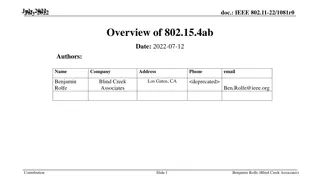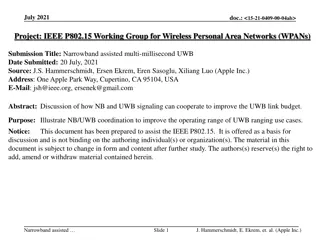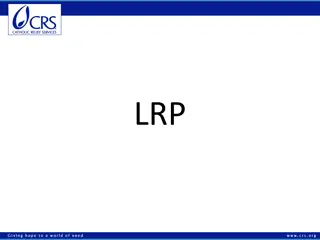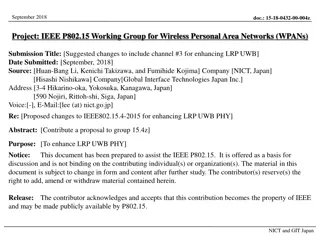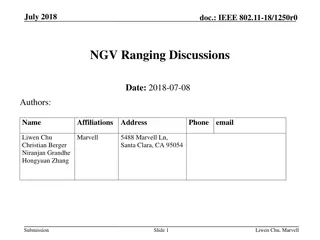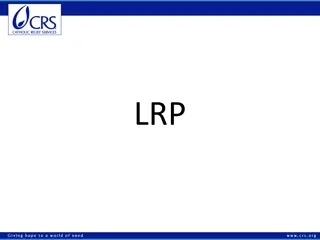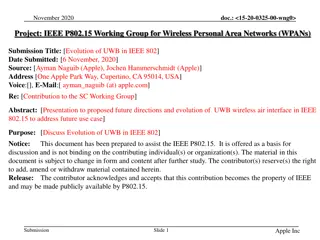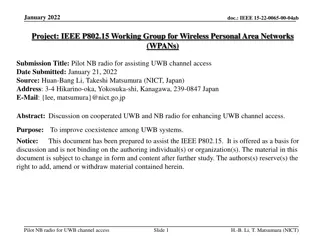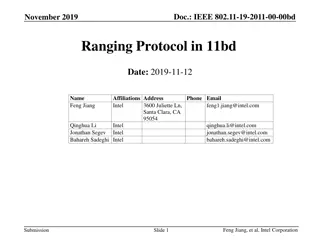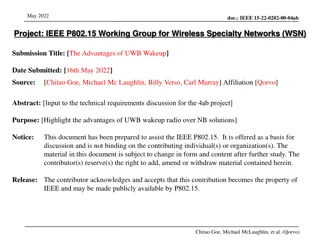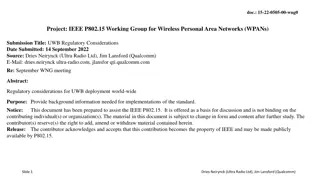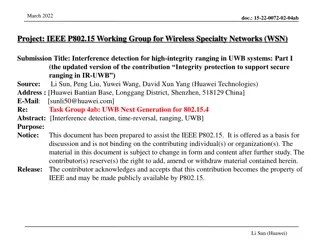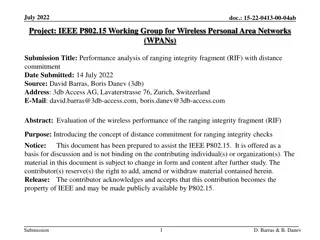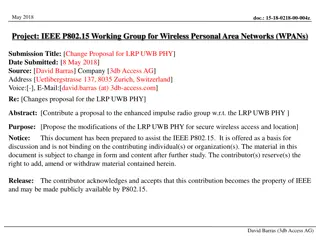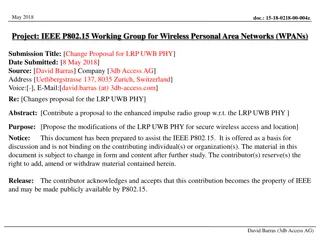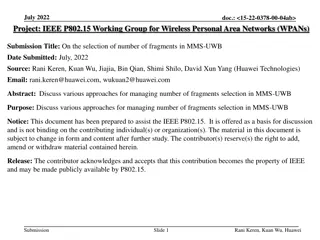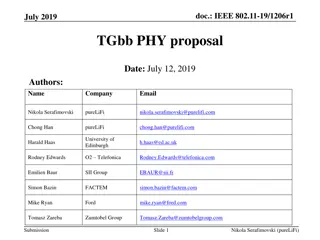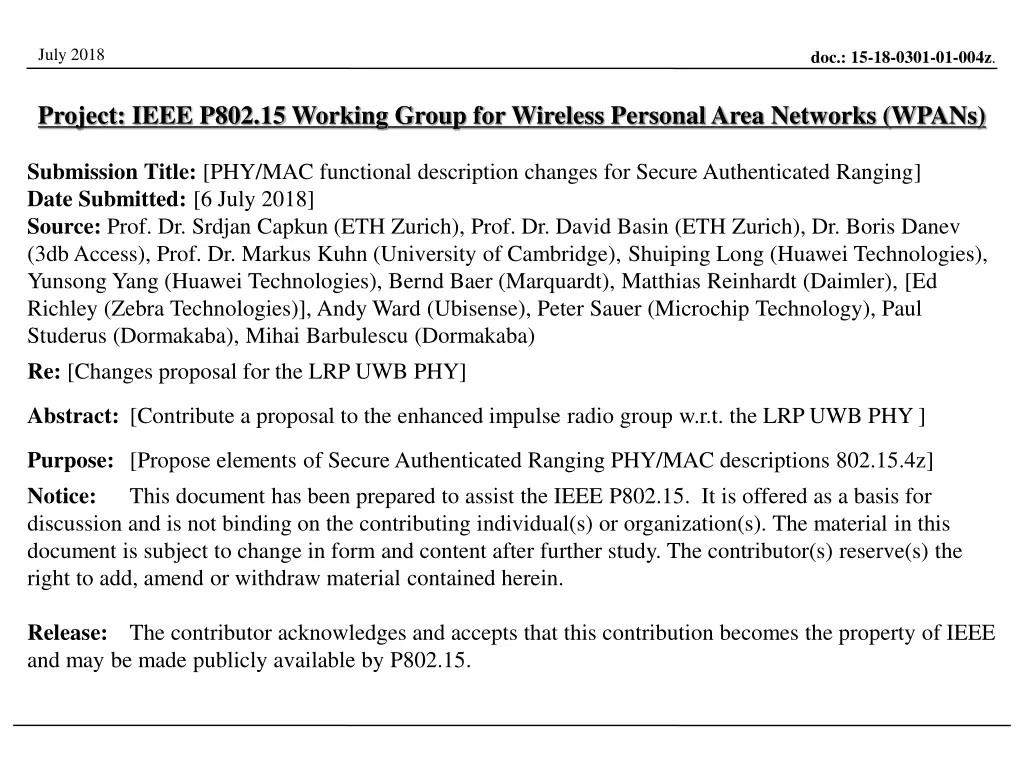
Secure Authenticated Ranging Proposal
Delve into the enhanced impulse radio group's proposal for IEEE P802.15 on Secure Authenticated Ranging PHY/MAC functionalities, emphasizing provably secure authenticated ranging and the market demand for low-cost, ultra-low power solutions with robust security measures to meet industry needs.
Download Presentation

Please find below an Image/Link to download the presentation.
The content on the website is provided AS IS for your information and personal use only. It may not be sold, licensed, or shared on other websites without obtaining consent from the author. If you encounter any issues during the download, it is possible that the publisher has removed the file from their server.
You are allowed to download the files provided on this website for personal or commercial use, subject to the condition that they are used lawfully. All files are the property of their respective owners.
The content on the website is provided AS IS for your information and personal use only. It may not be sold, licensed, or shared on other websites without obtaining consent from the author.
E N D
Presentation Transcript
July 2018 doc.: 15-18-0301-01-004z. Project: IEEE P802.15 Working Group for Wireless Personal Area Networks (WPANs) Submission Title: [PHY/MAC functional description changes for Secure Authenticated Ranging] Date Submitted: [6 July 2018] Source: Prof. Dr. Srdjan Capkun (ETH Zurich), Prof. Dr. David Basin (ETH Zurich), Dr. Boris Danev (3db Access), Prof. Dr. Markus Kuhn (University of Cambridge), Shuiping Long (Huawei Technologies), Yunsong Yang (Huawei Technologies), Bernd Baer (Marquardt), Matthias Reinhardt (Daimler), [Ed Richley (Zebra Technologies)], Andy Ward (Ubisense), Peter Sauer (Microchip Technology), Paul Studerus (Dormakaba), Mihai Barbulescu (Dormakaba) Re: [Changes proposal for the LRP UWB PHY] Abstract: [Contribute a proposal to the enhanced impulse radio group w.r.t. the LRP UWB PHY ] Purpose: [Propose elements of Secure Authenticated Ranging PHY/MAC descriptions 802.15.4z] Notice: This document has been prepared to assist the IEEE P802.15. It is offered as a basis for discussion and is not binding on the contributing individual(s) or organization(s). The material in this document is subject to change in form and content after further study. The contributor(s) reserve(s) the right to add, amend or withdraw material contained herein. Release: The contributor acknowledges and accepts that this contribution becomes the property of IEEE and may be made publicly available by P802.15.
July 2018 doc.: 15-18-0301-01-004z. ToC 1. Scope 2. Motivation 3. Concepts 4. MAC functional descriptions for secure authenticated ranging 5. Summary 6. Future evolution
July 2018 doc.: 15-18-0301-01-004z. Scope Provably secure authenticated ranging for: Mobile payments Corporate and Home Buildings access control Vehicle access control Cryptographic device authentication combined with secure distance measurement (e.g., Banking transactions, Bitcoin location) Provably secure authenticated rangingis only achievable by a set of PHY, for which energy carrying information is constrained on the shortest possible time period (such as LRP UWB PHYs). Ultimate security measure against all known logical and physical-layer relay attacks!
July 2018 doc.: 15-18-0301-01-004z. Scope Strong market demand across all verticals for: Low cost of ownership (minimum size and BOM) Ultra-low power consumption (coin cell battery, several years of battery life) Low complexity and easy set-up (robust design and tolerance to different propagation environments) Provable security (formally proven under state-of-art cryptographic models for worldwide industry adoption)
July 2018 doc.: 15-18-0301-01-004z. Motivation Secure authenticated ranging using LRP UWB perfectly builds on legacy IEEE 802.15.4 Security Fully complies with 802.15.4 Security as defined in Clause 9 Uses the security services as defined Clause 9 Matches the security levels defined in Clause 9 Provides the strongest security guarantees using one-way and mutual authentication Current state of the art in industrial security standards worldwide! Ensures evolution towards stronger AES-256 shared cryptography and public/private key (PK) cryptography Future trend in all security standards Formal proof
July 2018 doc.: 15-18-0301-01-004z. Concepts (1/3) Secure authenticated ranging relies on 2 fundamental concepts Secure authentication protocol (MAC layer) Distance commitment principle (PHY layer)
July 2018 doc.: 15-18-0301-01-004z. Concepts (2/3) Secure authentication protocol Challenge (Nonce) Response (Cryptographic function) Bob Alice Challenge and Response Nonce Freshly generated random number (e.g., 128 bits) Cryptographic function Encryption (e.g., AES), Authentication (e.g., SHA)
July 2018 doc.: 15-18-0301-01-004z. Concepts (3/3) Distance commitment principle The sender claims to be in a certain distance by the transmission time of the preamble The exact arrival time of the preamble at the receiver tells the receiver when to sample the signal in order to demodulate the MAC payload symbols carrying the secure data of the authentication protocol Distance commitment provides the strongest security guarantees against all physical layer attacks such as Early- detect and Late-commit. Annex G provides the worst case maximum distance decrease
July 2018 doc.: 15-18-0301-01-004z. MAC functional description changes for secure authenticated ranging Specify provably secure authenticated ranging in two modes: Secure ranging with one-way authentication Secure ranging with mutual authentication Provide formal security guarantees and proofs Annex G
July 2018 doc.: 15-18-0301-01-004z. Secure ranging (1/7) Purpose: A new MAC functional description is required for provably secure authenticated ranging Open Clause 6 in order to introduce a new subclause 6.17 Secure authenticated ranging Create Annex G (normative) in order to describe the security guarantees and provide the corresponding formal proofs Clause 6.17 named Secure authenticated ranging includes 6.17 Secure authenticated ranging 6.17.1 Secure ranging with one-way authentication 6.17.2 Secure ranging with mutual authentication 6.17.3 Distance commitment 6.17.4 Protocol verification procedure
July 2018 doc.: 15-18-0301-01-004z. Secure ranging (2/7) Security services Uses the security services for data authenticity defined in Clause 9 Based on AES-128 CCM* as defined in Clause 9 and Annex B MAC frame format Uses the MAC data format for security macSecurityEnabled shall be set to TRUE Need of additional IEs for secure ranging modes ? Define two modes of operation: one-way and mutual authentication
July 2018 doc.: 15-18-0301-01-004z. Secure ranging (3/7) With one-way authentication V (Verifier) P (Prover) VNonce VNonce, PResponse Generic access control where one party is authenticated Described in detail in 6.17.1
July 2018 doc.: 15-18-0301-01-004z. Secure ranging (4/7) With mutual authentication V (Verifier) P (Prover) VNonce PNonce, VNonce, PResponse VNonce, PNonce, VResponse Mobile payments, banking transactions, high security access control Described in detail in 6.17.2
July 2018 doc.: 15-18-0301-01-004z. Secure ranging (5/7) Distance commitment Ensures that the PSDU carrying the nonces and MIC is decoded at the measured distance defined by the first path. This is essential to secure ranging and provable security as defined in Annex G. SHR PHR PSDU Only the first pathportion of the signal is used during data decoding in the PSDU Channel Impulse Response is available at the end of the SHR First path Reflections t Distance commitment Described in detail in 6.17.3
July 2018 doc.: 15-18-0301-01-004z. Secure ranging (6/7) Protocol verification procedure Received nonce(s) have to match Computed MIC(s) have to match Described in detail in 6.17.4 Use of shared secret keys Mandate the use of link keys (i.e., pair-wise shared keys) between devices
July 2018 doc.: 15-18-0301-01-004z. Secure ranging (7/7) Annex G (normative) Security guarantees of secure authenticated ranging Provides the formal proofs Summary Table 1 of security guarantees Security Level Nonce length (bits) Probability of guessing the nonce Forging of MIC (as per AES CCM* in Clause 9) N/A MIC-32 MIC-64 Worst Case Maximum Distance Decrease N/A 14 cm 75 cm 14 cm 75 cm 14 cm 75 cm 0 1 2 3 N/A 32 64 128 N/A 1/2^32 (2.32e-10) 1/2^64 (5.42e-20) 1/2^128 (2.93e-39) MIC-128 Full security proofs and publication references in Annex G
July 2018 Optimal energy vs. security by LRP UWB doc.: 15-18-0301-01-004z. Authentication strength [Probability of forging the crypto authentication result] 1e-10 1e-20 1e-30 1e-40 5 100 200 300 400 500 Total secure ranging duration [us] 10 20 30 Total secure ranging energy [uJ] 40
July 2018 doc.: 15-18-0301-01-004z. Summary We proposed a new MAC functional description for provably secure ranging in two modes One-way authentication and mutual authentication Proposed provably secure ranging builds on the available security services of 802.15.4 for data authenticity It provides the highest state-of-art security guarantees for scalability and worldwide industry adoption Annex G provides the security guarantees and formal proofs Extended Mode can also be secured
July 2018 doc.: 15-18-0301-01-004z. Future evolution Wireless security standards evolve (e.g., NFC, 802.11) Shared cryptography will evolve to AES-256 Public/private key cryptography is becoming more spread Assuming next generation 802.15.4 will support AES-256 and/or public/private key cryptography The proposed secure authenticated ranging can be simply used with public key signatures, replacing MICs Proposed secure authenticated ranging is build to evolve according to future security trends and worldwide industry adoption
July 2018 doc.: 15-18-0301-01-004z. Q & A
July 2018 Secure ranging with pre-synchronization doc.: 15-18-0301-01-004z. VNonce and PNonce are preshared and known to P and V Nonces are used only once for ranging (can be derived from shared keys and counters) V (Verifier) P (Prover) VNonce VNonce, PResponse PNonce Given that nonces are preshared, V and P can tolerate high BER. E.g., even if 90% of the VNonce and PNonce match, V and P can still accept the ranging as secure with very strong guarantees => Scheme provides configurable robustness to bit (pulse) loss
July 2018 Secure ranging with pre-synchronization doc.: 15-18-0301-01-004z. The scheme provides configurable robustness to cryptographic information bit loss Gain from BER of 0.1% to BER of 10% (not coded) leads to 5.5 7.5 dB improvementdepending on the demodulation scheme Secure ranging with pre-synchronization further significantly enhances the reliability of the secure ranging!!!


